
- Rowing Tutorial
- Rowing - Home
- Rowing - Overview
- Rowing - Equipment
- How to Play Rowing?
- Rowing - Rules
- Rowing - Champions
- Rowing Useful Resources
- Rowing - Quick Guide
- Rowing - Useful Resources
- Rowing - Discussion
Rowing - Quick Guide
Rowing - Overview
Rowing is a sport in which a single player or a group of players propel a boat with the help of oars. If a single person is rowing, the boat is called single scull and if eight people are rowing then the boat is called coxed eight. The International Rowing Federation is the governing body of the sport that organizes the competitions in different parts of the world.
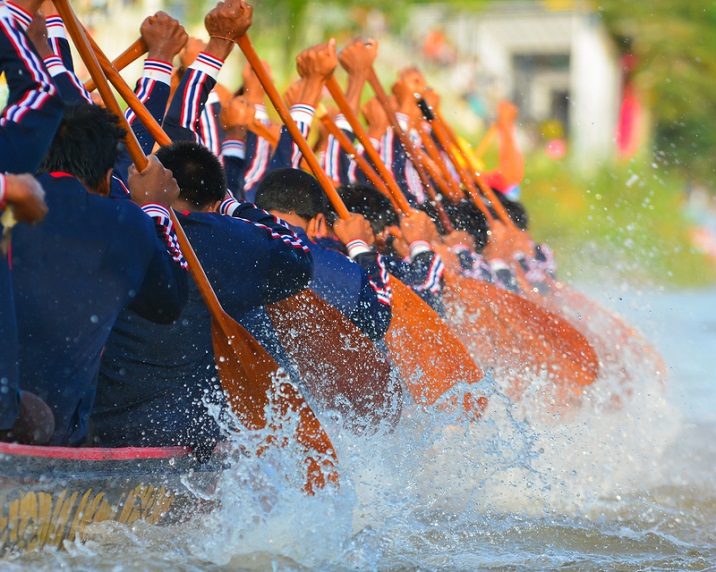
In a large lake, many such competitors sail in the water to exercise their luck. The beauty of this sport is that the oars which are the driving equipment are attached to riggings. They jut out from the side of the boats. The reason behind it is to increase the leverage by positioning them alternately on opposite sides of the vessel. Coxswain steers the boat by sitting at the back.
A Brief History of Rowing
The history of rowing traces to ancient countries like Egypt, Greece, and Rome. That time it was used as a means of transportation and business proposes. In the year 1828, Oxford Cambridge University organized boat racing for the first time. Sculling and sweep oars were the two earlier categories.
Men’s rowing competition was present since the inception of Olympic Games. Except all the events, in the year 1896, a stormy weather in the sea compelled the organisers to cancel the competition which was going to be held in Athens. Women made their debut in this competition in the 1976, which was held at Montreal.
Till 1960, USA dominated in the competitions and then it was the Soviet Union who continued their winning rhythm till 1980. After that, Germany showed its best in this game. Sir Steve Redgrave of Great Britain is known as the greatest rower ever. He has won five gold medals and is a six time world champion. On the other hand, Elisabeta Lipa of Romania has also won five gold medals in women’s category in between 1984 and 2004.
Participating Countries
Year by year the popularity of this sport is becoming so high that the number of participating countries rose to 68 in 2012 Summer Olympics from four as compared to 1896 Olympics. Many Asian and Non-Asian countries like Australia, Canada, China, Cuba, Denmark, Egypt, Germany, India, Japan and many others participate in this sport.
According to global ranking list, Great Britain tops the list with 118 points. The top 10 countries in overall global ranking are Great Britain, Germany, New Zealand, United States, France, Australia, Italy, Netherland, Lithuania, and China.
However in medal table list, East Germany is top in the list with having 33 gold medals in total. United States and Great Britain successfully follow the list having 32 and 28 gold medals respectively. In world championships, there is a few pass for the crews for the competition. Therefore; qualification events are organised to shortlist the crews.
Each National Olympic committee can have maximum one boat for competing in each event. Continental Qualification Regattas is another qualifying event which is organised prior to Olympics by FISA in different countries to shortlist the crews.
Rowing - Equipment
In this chapter, we will discuss about the equipment used in Rowing. Let us start with Racing Boats.
Racing Boats
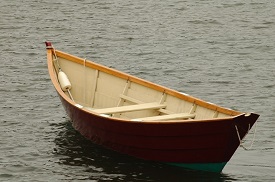
To reduce the drag to a minimum level while sailing, the boat is designed having semicircular cross section with long and narrow structure. To increase the effectiveness of the rudder, we usually connect a fin towards the rear. This also helps the boat from getting roll and yaw.
The categorization of the boats can be done either according to the number of rowers or according to the position of coxswain. There can be 1, 2, 4 or 8 number of rowers on the boat. Sometimes boats do not have any coxswain on them.
In sculling type of boats, the riggers are so designed that they apply force symmetrically on the either side of the boat, whereas in case of sweep oars type, the design allows the riggers to be applied alternatively. Therefore, it is the symmetrical force that is an utmost necessity in scull type boats. Similar comparison shows that double scull and quadruple scull are faster than coxless pair and coxless fours type.
Another type of boat, often called as a queep, is used mostly in UK and Canada. It can be made up of either shell of coxed or non-coxed. Apart from queep boats, trop and coxed trop are in fashion in Central Canada nowadays. The small difference that the coxed trop has a coxed positioned at the stern of the boat.
Oars
To propel the boat in the water, you need oars. They have long pole like structure having flat surface finishing at the end, which is of 50×25 cm configuration. However, the length of the pole varies according to the type of boats. For sculling type boats, the length varies between the ranges of 250-300 cm whereas rowing type boats maintain the length in between 340-360cm.
Oars have their different nomenclature, which varies according to the type of competition. In case of sweep oar rowing, they are termed as blade and in case of sculling, they are referred as scull. As in case of sculling, the oarsman chase around a great amount of water as compared to single rowing, therefore, sculling type oars have greater blade area as compared to sweep type.
Steering
Scullers are used for steering purpose in single, double and quad type scull boats by giving pulling force on either one or on both sides. Some other boats, where coxswains are present, control the boat through rudder.
In the absence of coxswain, the duty is done by a crew. Sometimes the crew control through a rudder cable, attached to the toes. Strokesman present on the straight course can point the stern to a particular point at the beginning.
Rowing Tank
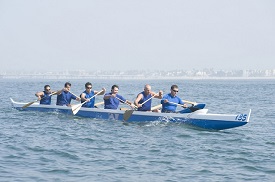
Before going for actual race, the riders practice the session in an artificial tank that mimics the exact tournament condition. This tank is called as rowing tank. In this tank, the water is propelled in artificial way to give the exact feeling of rowing on the stream lines.
Beginners are trained in this tank initially. This tank also comes handy for practising, when the bad weather condition does not permit to row in the outside stream. It is also used in offseason when the water current is not coherent for rowing.
Ergometers
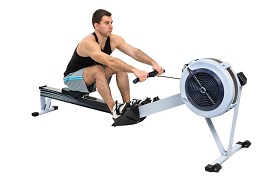
Indoor rowing instruments are known as ergometers. This device measures the amount of work performed by the rowers. By using this equipment, we can actually calibrate the amount of energy that a rower poses for actual competition.
It is part of daily training session that the rowers go through. The practitioners are all the members of a certain team that is going to compete along with many others in a tournament.
Rowers practice their skills every day and focus on improvising it. In short, we can say that rowing fitness can be effectively measured through it on the ground, where waterborne training is restricted.
Those who are experienced on water can get an effective workout through its use. Performance upon this is not considered as a selection criterion for crews. To mimic the water movement actions, slides are placed below the ergometers. It will give you an experience as if you are sailing in the water.
Rowing - How to Play?
Rowing is not limited to sports, rather people use it for personal entertainment also. This sport demands much power because in world championship tournaments, the rowers actually do need to move a long distance of over 2 kilometres in just a time span of 5-7 minutes.
Unlike other sports like bicycling, a rower needs higher pumping inside his lungs to intake much air in order to produce more force. Therefore, the rowers are advised to inhale and exhale twice per stroke to maintain the power level. There are different types of racing present in a rowing competition.
Some of the important categories are −
- Side-by-side race
- Head races
- Bumps race
- Stake race
Let’s discuss in detail about these different types of races.
Side-by-Side Race
In this type of racing, all the boats start at the same time. The boat which crosses the finishing line first is declared as the winner. This game is often known by some other names such as regatta or sprint racing. The number of boats competing in this can vary from minimum two to maximum 6.
The distance of race in this type of category varies usually from competition to competition. The following table lists some of the important championships and their racing distance.
| Championship | Racing Distance (in Km) |
|---|---|
| World Rowing Championship | 2 |
| US High School Race Juniors | 1.5-2 |
| Tour du Leman | 160 |
| Corvallis to Portland regatta | 185 |
A series of heats are organised in a single side by side racing. Fastest teams in each series qualify for the next series. The losing teams however are given a second chance where they exercise their luck and power, popularly known as repechage.
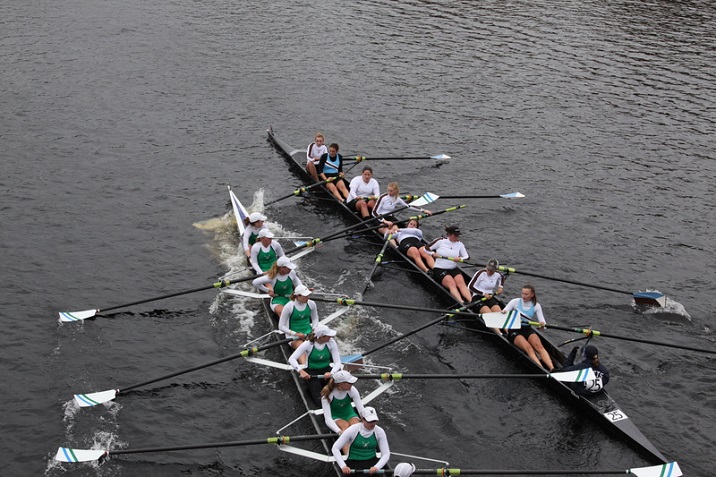
Head Race
The duration between autumn to early spring is the perfect time for head racing. Rolling of boats starts with a regular interval of 10-20 seconds. Their destination is fixed at a certain distance. The length of the distance varies in between 2Km to 12Km.
Head of the river race is the oldest and famous head race that takes place in March every year at the bank of Thames in London. Head of the Charles regatta is the largest head race rowing event that is organised on the bank of Charles River in Massachusetts. The fastest crew in this type of racing is crowned as Head of the river title.
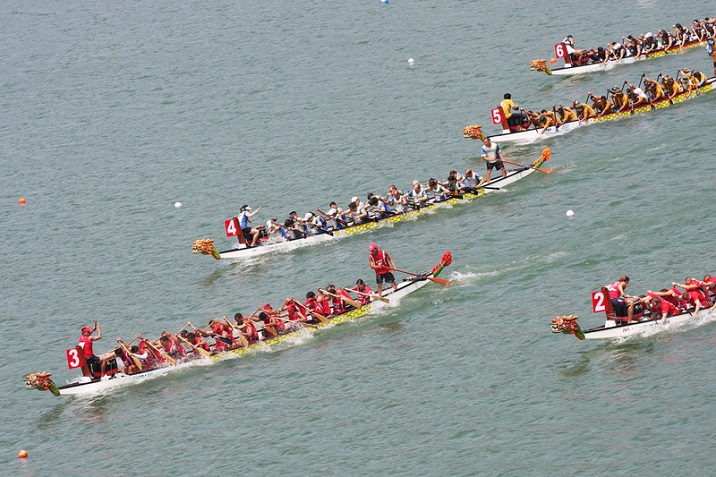
Bump Racing
This type of racing is a multi-day event. Here the crews line up at the bank of river at every frequent intervals. They all march towards a particular direction one after another. The main thing in this type of racing is that the crew should avoid getting hit from behind.
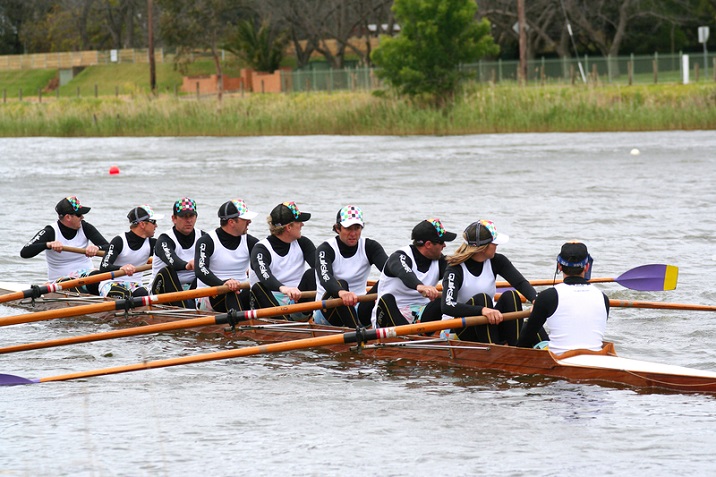
The physical contact made by a boat with another one is termed as bump. Therefore, in this type of racing. damage to a boat is an obvious thing. Just before getting bumped, the cox of that boat may concede. It will rescue his boat from getting physical damage. The very next day the bumping boat will ride ahead of the bumped boats. Their position at the last day of the match determines their position for the next year match.
Stake Race
Early Americans used to organise this type of racing. This is actually a race around a stake turn. Relay style and head to head types of boats are frequently used in this race. After one boat crosses the finishing line, the next boat departs. Here mastery of steering is required for 180 degree turn. Sometimes one turn is enough and sometimes three turns can also be seen. Distance varies from tournament to tournament; ranging from 500 metres to 2.3 Km.
Rowing - Rules
The rules of Rowing vary according to the governing bodies of different countries. However, international rules are defined by Fédération Internationale des Sociétés d'Aviron (FISA). Maximum rules are same with a slight difference among them. For example buoyancy aids are compulsory to wear for the coxswains all the time under British rowing federation whereas, in FISA no such rules are there.
Boat Position
Except single sculls, rowers are numbered in a sequential manner in a boat. Man nearer to the bow is numbered as first and continues to increase as we move towards the person sitting at stern. A bowman always positions himself at the first seat whereas, the person who sits close to the stern is known as strokeman.
Stern pairs are given the task for setting up stroke rate and also to maintain the rhythm in a boat. More powerful rowers are positioned in the middle of the boat. They are having less technical knowledge as compared to the stern pairs.
Rowing − Important Terminologies
For naming an event, different nomenclature systems are used in a rowing competition. The aim behind is to understand many facts like age, weight, gender and size of boat by just looking at this symbols. Letter L or Lt is used to signify lightweight category. Similarly symbols J and B are used to recognise team.
Let’s summarize here some other important abbreviations.
Abbrevations for sculling boats
| Abbrevation | Name of the Boat |
|---|---|
| 1× | Single scull |
| 2× | Double scull |
| 4×+ | Coxed quadruple scull |
| 4×- | Coxless quadruple scull |
| 8×+ | Coxed Octuple scull |
Abbrevations for Rowing boats
| Abbrevation | Name of the Boat |
|---|---|
| 2+ | Pairs having Cox |
| 2− | Coxless pair |
| 4+ | Coxed four |
| 4− | Coxless four |
| 8+ | Coxed Eight |
Rowing - Champions
Various events that are organized under different categories is shown in the following table.
| Category | Events | Category | Events |
|---|---|---|---|
| Men |
|
Women |
|
| LightWeight men |
|
Lightweight women |
|
Some major tournaments of rowing include −
- Rowing World Championship
- Summer Olympics
- European Rowing Championship
- NCAA Rowing Championship
- Indoor Rowing Championship
Let us now discuss briefly about some greatest rowing athletes that the World has ever produced.
Steve Redgrave
Steve Redgrave is a competitor for Great Britain. He has an excellent Olympic track record that has five gold medals and one bronze medal.
He has also won three gold medals in Commonwealth Games and nine gold medals, two silver medals and one bronze medal in World Rowing Championships.
IOC president Juan Antonio honored him with gold Olympic pin in 2000 Summer Olympics for his excellent achievements. After winning a gold in 2000 Olympics, he retired from the sport.
Drew Ginn
Drew Ginn is a competitor for Australia. In his Olympic career, he bagged three gold medals and one silver medal, out of which a gold and a silver were won in coxless four category and two golds were won in coxless pair category.
In World Championships, he has an excellent record track with eight medals out of which five are gold, one is silver and two are bronze.
Out of the eight medals in World Championships, he won a gold in coxed four category a bronze in eight category, another bronze in coxless four category, and four golds and one silver in coxless pair category.
Elisabeta Lipa
Elisabeta Lipa was a player belonging to Romania. She has won eight medals in her 20years Olympic career which includes five gold medals, two silver medals and one bronze medal.
In the Olympics, she won one gold and two silvers in double sculls category, one gold in single sculls, three golds in eight and one bronze in quadruple sculls.
Elisabeta has also won one gold, eight silvers and four bronzes in World Championships. Thomas Keller medal was awarded to her in 2008 Rowing World Cup.
Georgeta Damian
Georgeta Damian is a female rower competing for Romania. In her Olympic career, she bagged five gold medals and one bronze medal out of which three golds were in coxless pair category and two golds and one silver in eight category.
She has also won many medals in World Championships five golds, three silvers, and one bronze.
Out of the medals in World Championships, she has won three golds and two silvers in eight category and two golds, one silver, and one bronze in coxless pair category.
To Continue Learning Please Login